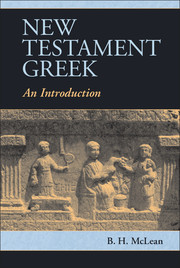Book contents
- Frontmatter
- Contents
- Abbreviations
- Introduction
- 1. Alphabet and Pronunciation
- 2. Writing Greek Letters, Accents, Diacritical Marks, and Punctuation
- 3. Present and Future Active Indicative, Present Active Indicative of the Verb “to be,” and Particles
- 4. Contract Verbs, Present and Future Active Indicative, and Future Indicative of Liquid Verbs
- 5. Second Declension, the Definite Article, and Prepositions
- 6. First Declension and the Definite Article
- 7. Adjectives, Demonstrative Pronouns, and Comparison
- 8. Personal Pronouns, Relative Pronouns, and Reflexive Pronouns
- 9. First Aorist Active Indicative
- 10. Verbal Roots, Principal Parts, and Second Aorist Active Indicative
- 11. Present Middle and Passive Indicative, Future Middle Indicative, and Future Indicative of the Verb “to be”
- 12. Imperfect Active Indicative and Imperfect of the Verb “to be”
- 13. Imperfect Middle and Passive Indicative and First and Second Aorist Middle Indicative
- 14. Third Declension Nouns and Adjectives: Part 1
- 15. Third Declension Nouns and Adjectives: Part 2
- 16. Perfect and Pluperfect Active, Middle, and Passive Indicative
- 17. Aorist Passive and Future Passive Indicative
- 18. Present and Aorist Participles
- 19. Aorist Passive Participle, Perfect Participle, Adverbial Participles, Genitive Absolute, and Periphrastic Constructions
- 20. The Athematic Conjugation (-μι verbs): Part 1 – The Indicative Mood
- 21. The Athematic Conjugation (-μι verbs): Part 2 – δείκνυμι, ϕημί, and Participles
- 22. Subjunctive Mood and Conditional Sentences
- 23. The Infinitive
- 24. Imperative Mood
- Appendix 1. Principal Parts of the Greek Verb
- Appendix 2. Summary of Paradigms
- Summary of Vocabulary to Be Memorized
- Subject Index
- Index of Greek Words Discussed
- Lexicon of Greek Words in Texts for Translation
- References
4. - Contract Verbs, Present and Future Active Indicative, and Future Indicative of Liquid Verbs
Published online by Cambridge University Press: 05 June 2012
- Frontmatter
- Contents
- Abbreviations
- Introduction
- 1. Alphabet and Pronunciation
- 2. Writing Greek Letters, Accents, Diacritical Marks, and Punctuation
- 3. Present and Future Active Indicative, Present Active Indicative of the Verb “to be,” and Particles
- 4. Contract Verbs, Present and Future Active Indicative, and Future Indicative of Liquid Verbs
- 5. Second Declension, the Definite Article, and Prepositions
- 6. First Declension and the Definite Article
- 7. Adjectives, Demonstrative Pronouns, and Comparison
- 8. Personal Pronouns, Relative Pronouns, and Reflexive Pronouns
- 9. First Aorist Active Indicative
- 10. Verbal Roots, Principal Parts, and Second Aorist Active Indicative
- 11. Present Middle and Passive Indicative, Future Middle Indicative, and Future Indicative of the Verb “to be”
- 12. Imperfect Active Indicative and Imperfect of the Verb “to be”
- 13. Imperfect Middle and Passive Indicative and First and Second Aorist Middle Indicative
- 14. Third Declension Nouns and Adjectives: Part 1
- 15. Third Declension Nouns and Adjectives: Part 2
- 16. Perfect and Pluperfect Active, Middle, and Passive Indicative
- 17. Aorist Passive and Future Passive Indicative
- 18. Present and Aorist Participles
- 19. Aorist Passive Participle, Perfect Participle, Adverbial Participles, Genitive Absolute, and Periphrastic Constructions
- 20. The Athematic Conjugation (-μι verbs): Part 1 – The Indicative Mood
- 21. The Athematic Conjugation (-μι verbs): Part 2 – δείκνυμι, ϕημί, and Participles
- 22. Subjunctive Mood and Conditional Sentences
- 23. The Infinitive
- 24. Imperative Mood
- Appendix 1. Principal Parts of the Greek Verb
- Appendix 2. Summary of Paradigms
- Summary of Vocabulary to Be Memorized
- Subject Index
- Index of Greek Words Discussed
- Lexicon of Greek Words in Texts for Translation
- References
Summary
Contract Verbs
There are many verbs whose stems end in a vowel, either -ε, -α, or -ο. These final vowels combine, or contract, with the connecting vowels of the personal endings. These so-called “contract” verbs can be grouped into the following three categories:
ε-contract verbs
α-contract verbs
ο-contract verbs
As you review the contraction of vowels in the paradigms below, you will notice that some vowels dominate other vowels. This is termed the principle of phonodynamism. As a way of beginning to understand contract verbs, review some of the basic guidelines of contraction, as oulined below, and then turn to the example verbs for specifics. In general you will note that:
o-sounds tend to prevail over all other vowel sounds, whether preceding or succeeding.
when a-sounds and e-sounds meet, the intial sound takes precedence; thus α + ε → α, but ε + α → η.
iota (ι), whether written as subscript, or sounded, does not disappear.
- Type
- Chapter
- Information
- New Testament GreekAn Introduction, pp. 40 - 45Publisher: Cambridge University PressPrint publication year: 2011



